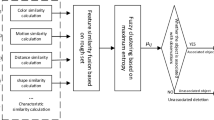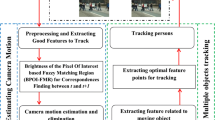Abstract
Motion correspondence problem between many feature points of consecutive frames is computationally explosive. We present a heuristic algorithm for finding out the most probable motion correspondence of points in consecutive frames, based on fuzzy confidence degrees. The proposed algorithm consists of three stages: (i) reduction of the search space for candidate points of association, (ii) pairwise association cost estimation and (iii) complete association of every feature point between the consecutive frames. In the first stage, all the points in a frame, frame t-1 are grouped into several groups by using fuzzy clustering. This is done with a Euclidean distance as a similarity measure between the points. The points in the following frame, frame t are also clustered into the same number of groups with respect to the cluster centers of the previous frame. The association between the points of the consecutive frames is allowed only for the points that belong to the same group in each frame. In the second stage, the cost of each association of a point in frame t-1 with a point in frame t is estimated by using motion constraints that are based on the velocity vector and the orientation angle of each point. The cost is measured as a fuzzy confidence degree of each head point, i.e., a point in frame t-1, belonging to each measurement, i.e., a point in frame t. In the final stage, we search for the most likely associations among all the possible mappings between the feature points in the consecutive frames. A search tree is constructed in such a way that an ith level node represents an association of ith node in frame t-1 with a node in frame t. We devise a heuristic function of an admissible A* algorithm by using the pairwise association cost developed in the second stage. Experimental results show an accuracy of more than 98%.
Similar content being viewed by others
References
J. Y. Jung and M. H. Kim, “Automatic feature point extraction and tracking in image sequences with the multiple moving objects,” Journal of The Korean Institute of Information Scientists and Engineers, vol. 25, no. 3, pp. 562–573, March 1998.
K. Y. Eom, J. Y. Jung, and M. H. Kim, “A motion correspondence algorithm based on point series similarity,” Journal of The Korean Institute of Information Scientists and Engineers, vol. 37, no. 4, pp. 305–310, April 2010.
K.-Y. Eom, T.-K. Ahn, G.-J. Kim, G.-J. Jang, and M.-H. Kim, “Fast object tracking in intelligent surveillance system,” Proc. of ICCSA 2009, Part II, LNCS 5593, pp. 758–772, July 2009.
I. Sethi and R. Jain, “Finding trajectories of feature points in a monocular image sequence,” IEEE Trans. on Pattern Analysis and Machine Intelligence, vol. 9, no. 1, pp. 56–73, January 1987.
K. Rangarajan and M. Shah, “Establishing motion correspondence,” Conference Vision Graphics Image Process, vol. 54, no. 1, pp. 56–73, July 1991.
C. J. Veenman, M. J. T. Reinders, and E. Backer, “Resolving motion correspondence for densely moving points,” IEEE Trans. on Pattern Analysis and Machine Intelligence, vol. 23, no. 1, pp. 54–72, January 2001.
K. Shafique and M. Shah, “A noniterative greedy algorithm for multiframe point correspondence,” IEEE Trans. on Pattern Analysis and Machine Intelligence, vol. 27, no. 1, pp. 51–65, January 2005.
L. Chen, M. T. Ozsu, and V. Oria, “Robust and fast similarity search for moving object trajectories,” Proc. of ACM SIGMOD, pp. 491–502, 2005.
A. Yilmaz, O. Javed, and M. Shah, “Object tracking: a survey,” ACM Computing Surveys, vol. 38, no. 4, pp. 1–45, 2006.
J. H. Kao, J. H. Chuang, and M. L. Hsieh, “Finding point correspondence using local similarity and global constraint under insignificant scaling and roll,” Electronics Letters, vol. 42, no. 23, pp. 1340–1341, November 2006.
R. R. Yager and D. P Filev, “approximate clustering via the mountain method,” IEEE Trans. on Systems, Man, and Cybernetics, vol. 24, no. 8, pp. 1279–1284, 1994.
J. S. Marques, “A fuzzy algorithm for curve and surface alignment,” Pattern Recognition Letters, vol. 19, no. 9, pp. 797–803, 1998.
Z. Xue, D. Shen, and E. K. Teoh, “An efficient fuzzy algorithm for aligning shapes under affine transformations,” Pattern Recognition, vol. 34, pp. 1171–1180, 2001.
P. E. Hart, N. J. Nilsson, and B. Raphael, “A formal basis for the heuristic determination of minimum cost paths,” SIGART Newsletter, vol. 37, pp. 28–29, 1972.
CAVIAR project, http://homepages.inf.ed.ac.uk/rbf/CAVIAR
PETS 2009, http://www.cvg.rdg.ac.uk/PETS2009/
F. Yin, D. Makris, and S. Velastin, “Performance evaluation of object tracking algorithms,” Proc. of the 10th Workshop on PETS2007, pp. 17–24, 2007.
T. K. An and M. H. Kim, “Context-aware video surveillance system,” Journal of Electrical Engineering & Technology, vol. 7, no. 1, pp. 115–123, 2012.
Author information
Authors and Affiliations
Corresponding author
Additional information
Recommended by Editorial Board member Yangmin Li under the direction of Editor Young-Hoon Joo.
Ki-Yeol Eom received his BSc degree in Applied Statistics from Sejong University, Seoul, Korea, in 1995 and his MSc degree in Information and Communications from Sungkyunkwan University, Seoul, Korea, in 2006. He received his Ph.D. in School of Information and Communication Engineering from Sungkyunkwan University, Seoul, Korea, in 2011. Since 2010, he has been a researcher in Korea Institute of Industrial Technology. His research interests include computer vision, pattern recognition, fuzzy inference, artificial intelligence.
Jae-Young Jung received his B.S., M.S., and Ph.D. degrees in Information Engineering from Sungkyunkwan University, Korea, in 1989, 1993 and 1997, respectively. He joined the department of computer information warfare at Dongyang University, Youngju, Korea in 1997, where he is currently an associate professor. His research interests include computer vision, augmented reality and image compression.
Moon-Hyun Kim received his B.S. degree in Electronic Engineering from Seoul National University in 1978, an M.S. degree in Electrical Engineering from KAIST, Korea, in 1980, and a Ph.D. degree in Computer Engineering from the University of Southern California in 1988. From 1980 to 1983, he was a Research Engineer at the Daewoo Heavy Industries Co., Seoul. He joined the School of Information and Communication Engineering, Sungkyunkwan University, Seoul, Korea in 1988, where he is currently a Professor. In 1995, he was a Visiting Scientist at the IBM Almaden Research Center, San Jose, California. In 1997, he was a Visiting Professor at the Signal Processing Laboratory of Princeton University, Princeton, New Jersey. His research interests include computer vision, pattern recognition, and artificial intelligence.
Rights and permissions
About this article
Cite this article
Eom, KY., Jung, JY. & Kim, MH. A heuristic search-based motion correspondence algorithm using fuzzy clustering. Int. J. Control Autom. Syst. 10, 594–602 (2012). https://doi.org/10.1007/s12555-012-0317-5
Received:
Revised:
Accepted:
Published:
Issue Date:
DOI: https://doi.org/10.1007/s12555-012-0317-5




